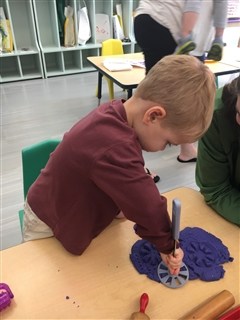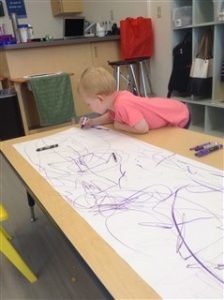Materials
Sets of plastic measuring cups and measuring spoons
Directions
Place the cups and spoons on the floor around your baby. Observe as he reaches to grab the toys. If his aim isn’t quite accurate yet, place the measuring spoons in his hand and encourage him to hold them. Most likely the spoons or cups will go right in his mouth since gumming and mouthing objects is how babies learn about the world at this age.
As your baby manipulates the cups and spoons by dropping them, picking them up, and placing them in his mouth, your baby learns about using his arms and hands. Exploring objects by mouth helps a baby learn about physical properties such as smooth, rough, cold, hard, heavy, and light.



 Read the story, Harold and the Purple Crayon by Crockett Johnson. Provide large sheets of white construction paper and purple crayons. Invite your child to draw and explore with a purple crayon. Where does it take her? What does she do? What experiences does your child have with the purple crayon? Have fun!
Read the story, Harold and the Purple Crayon by Crockett Johnson. Provide large sheets of white construction paper and purple crayons. Invite your child to draw and explore with a purple crayon. Where does it take her? What does she do? What experiences does your child have with the purple crayon? Have fun!

